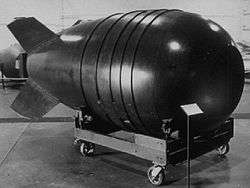1958 Mars Bluff B-47 nuclear weapon loss incident
|
A Mk 6 nuclear bomb similar to the one dropped in the incident | |
| Incident summary | |
|---|---|
| Date | March 11, 1958 |
| Summary | Inadvertent nuclear weapon release |
| Site |
Mars Bluff, South Carolina 34°12′3.25″N 79°39′25.66″W / 34.2009028°N 79.6571278°WCoordinates: 34°12′3.25″N 79°39′25.66″W / 34.2009028°N 79.6571278°W |
| Crew | 3 |
| Fatalities | 0 |
| Injuries (non-fatal) | 6 civilians |
| Aircraft type | Boeing B-47E-LM Stratojet |
| Operator | 375th Bombardment Squadron, 308th Bombardment Wing, United States Air Force (USAF) |
| Registration | 53-1876A |
| Flight origin | Hunter Air Force Base |
| Destination | RAF Bruntingthorpe |
The 1958 Mars Bluff B-47 nuclear weapon loss incident was an inadvertent nuclear weapon release over Mars Bluff, South Carolina, during 1958. The bomb, which lacked the fissile nuclear core, fell over the area causing minor structural damage to buildings below.[1] Six people were injured by the explosion of the bomb's conventional explosive load. The United States Air Force (USAF) was sued by the family of the victims, who received US$54,000, equivalent to $443,647 in 2015.[2][3]
Description of incident

On March 11, 1958, a U.S. Air Force Boeing B-47E-LM Stratojet from Hunter Air Force Base operated by the 375th Bombardment Squadron of the 308th Bombardment Wing near Savannah, Georgia, took off at approximately 4:34 PM and was scheduled to fly to the United Kingdom and then to North Africa as part of Operation Snow Flurry.[4][5] The aircraft was carrying nuclear weapons on board in the event of war with the Soviet Union breaking out. Air Force Captain Bruce Kulka, who was the navigator and bombardier, was summoned to the bomb bay area after the captain of the aircraft, Captain Earl Koehler, had encountered a fault light in the cockpit indicating that the bomb harness locking pin did not engage. As Kulka reached around the bomb to pull himself up, he mistakenly grabbed the emergency release pin. The Mark 6 nuclear bomb dropped to the floor of the B-47 and the weight forced the bomb bay doors open, sending the bomb 15,000 ft (4,600 m) down to the ground below.[6]
Two sisters, six-year-old Helen and nine-year-old Frances Gregg, along with their nine-year-old cousin Ella Davies, were playing 200 yards (180 m) from a playhouse in the woods that had been built for them by their father Walter Gregg, who had served as a paratrooper during World War II. The playhouse was struck by the bomb. Its conventional high explosives detonated, destroying the playhouse, and leaving a crater about 70 feet (21 m) wide and 35 feet (11 m) deep. Fortunately, the fissile nuclear core was stored elsewhere on the aircraft. All three girls were injured by the explosion, as were Walter, his wife Effie and son Walter, Jr. Seven nearby buildings were damaged. The United States Air Force (USAF) was sued by the family of the victims, who received US$54,000, equivalent to $443,647 in 2015.[2][3][4] The incident made national and international headlines.[7][8] The crater is still present today, although overgrown by vegetation, and is marked by a historical marker; however, access to the site is limited because it is located on private property with no public access road.[2]
See also
References
- ↑ Klepper, David (24 March 2011). "Man Recalls Day A Nuclear Bomb Fell On His Yard". The Sun News - SC. Retrieved 25 August 2014.
- 1 2 3 Bond, Anthony (26 April 2012). "The day a nuclear bomb fell on South Carolina". Daily Mail. Retrieved 23 August 2014.
- 1 2 Didymus, Johnthomas (27 April 2012). "Air Force accidentally dropped nuclear bomb on S. Carolina, 1958". Retrieved 25 August 2014.
- 1 2 "Armed Forces: Mars Bluff". Time. 24 March 1958. Retrieved 24 August 2014.
- ↑ Montgomery, Warner M. (21 March 2008). "Atomic Bomb dropped on Florence, S.C.". Retrieved 24 August 2014.
- ↑ Rumrill, Clark (September 2000). "Aircraft 53-1876A Has Lost A Device". American Heritage. 51 (5). Retrieved 24 August 2014.
- ↑ "Unarmed Atom Bomb Hits Carolina Home, Hurting 6". The New York Times. 12 March 1958.
- ↑ "Accidents stir concern here and in Britain". Oxnard Press-Courier. 12 March 1958. Retrieved 24 August 2014.
External links
- "'Dead' A-Bomb Hits US Town", Universal Newsreel story, Internet Archive.
- Florence County Museum
